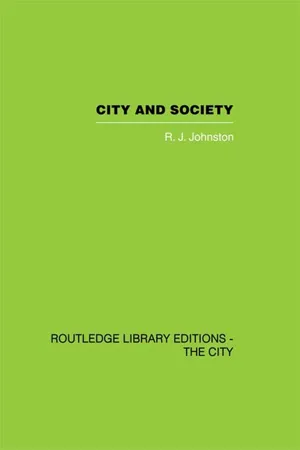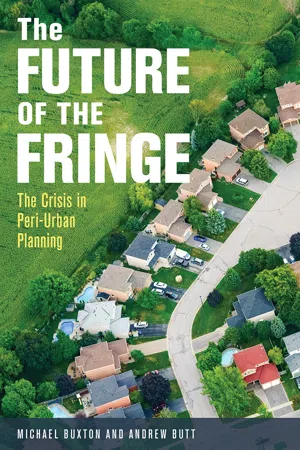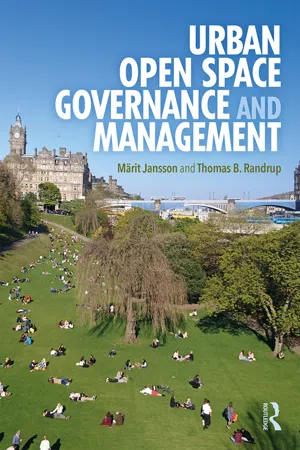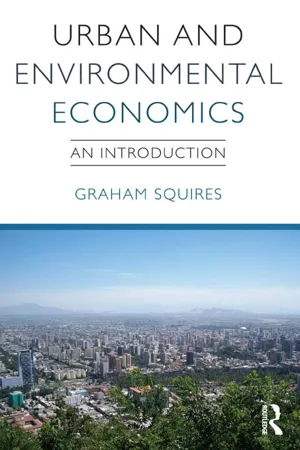Geography
Urban Functions
Urban functions refer to the various activities and roles that cities perform, such as residential, commercial, industrial, and recreational functions. These functions are essential for the functioning and development of urban areas and are often interconnected, shaping the social, economic, and environmental dynamics of cities. Understanding urban functions is crucial for urban planning and sustainable development.
Written by Perlego with AI-assistance
Related key terms
Related key terms
1 of 4
Related key terms
1 of 3
7 Key excerpts on "Urban Functions"
- eBook - ePub
Urban Geography (Routledge Revivals)
An Introductory Guide
- David Clark(Author)
- 2013(Publication Date)
- Routledge(Publisher)
Geography is scientific in so far as it aims to develop general rather than unique explanations of spatial patterns and distributions. It proceeds from the assumption that there is basic regularity and uniformity in the location and occurrence of phenomena and that this order can be identified and accounted for by geographical analysis. In examining spatial structure, geography focuses upon those distributional characteristics that are common to a wide range of phenomena. To this end, emphasis in geographical study is placed upon models and theories of location rather than upon descriptions of individual features. The overriding aim is to develop an understanding of the general principles which determine the location of human and physical characteristics.Urban geography is that branch of geography that concentrates upon the location and spatial arrangement of towns and cities. It seeks to add a spatial dimension to our understanding of urban places and urban problems. Urban geographers are concerned to identify and account for the distribution of towns and cities and the spatial similarities and contrasts that exist within and between them. They are concerned with both the contemporary urban pattern and with the ways in which the distribution and internal arrangement of towns and cities have changed over time. Emphasis in urban geography is directed towards the understanding of those social, economic and environmental processes that determine the location, spatial arrangement and evolution of urban places. In this way, geographical analysis both supplements and complements the insights provided by allied disciplines in the social and environmental sciences which recognise the city as a distinctive focus of study.Types of Urban Geographical StudyThe scope and nature of urban geography is best illustrated by reference to the data on towns and cities that typically form the starting point for urban geographical study. Two basic types of data are in fact necessary to summarise the geographical characteristics of urban places, the one relating to land using activities such as population, housing and industry, the other to the different types of exchange, linkage and interaction which take place within and between centres (Figure 1.1 - eBook - ePub
City and Society
An Outline for Urban Geography
- R.J. Johnston(Author)
- 2013(Publication Date)
- Routledge(Publisher)
Most societies, and certainly those of North America, Western Europe and Australasia where this ‘new geography’ developed, focus their activities in and on urban places. The majority of economic functions – in manufacturing, administration and service provision – and of social activities take place in towns and cities, and those which do not, notably agriculture, are articulated through the urban places, on which virtually all routes focus and in which most buying and selling occurs. Thus it is not surprising that the study of urban geography was central to the ‘new geography’ of the 1950s and 1960s, and this centrality was encouraged by the increased amount of urban planning undertaken.Urban geographers have developed two main types of research interest during this period of growth in the study of spatial organization, the two types representing analysis at different spatial scales. At the larger scale, they investigate the role of the town within the system of urban places, usually at a national or regional level; at the smaller scale, they analyse the characteristics of different areas within individual towns and cities. These two types are not independent, and methods developed for one have frequently been adopted for the other. Together, they define the current research concerns of most urban geographers.The study of urban places and urban systems
As indicated above, urban geographers have not been concerned simply to catalogue the activities of the residents of the towns that they study; their aim is to make generalizations about such activities, generalizations which apply to a large proportion of, if not all, towns. A large number of different topics is approached within this broad orientation, but they can be grouped into three characteristic concerns. - eBook - ePub
Sustainable Urban Development Volume 2
The Environmental Assessment Methods
- Mark Deakin, Gordon Mitchell, Peter Nijkamp, Ron Vreeker(Authors)
- 2007(Publication Date)
- Routledge(Publisher)
Urbanisation economies and shopping externalities are particularly likely to result from multi-functional land use. Obviously, historical development and topographical features do not change as a result of the combination of functions in space. The final factor technological development is an important reason for the development of the concept of multi-functional land use. Not only improvements in construction techniques, but also developments in ICT possibilities have created new insights into opportunities for combining economic activities. Another important element must be taken into account concerning location decisions and multi-functional land use: scarcity of land. The scarcity of land is an important reason for the development of multi-functional land use. People do not want only to live in densely populated areas, but also want to be able to work, shop, move around, etc. in order to maximise their utility. If all these different activities have to be carried out in a limited space, land use functions will have to be combined (e.g., by using the third and/or fourth dimension). This type of development corresponds with one of the main characteristics of the urban economy – the interdependence of land uses, which is largely created by external economies and diseconomies of production and consumption. These interdependencies bring about entirely different uses and values in areas with the same level of general accessibility. The theories on the concentric ring pattern of the spatial distribution of land use and the smooth pattern of the rent gradient may, therefore, have to be modified. The spatial distribution of land use patterns can be expected to become far more patchy as complementary land use patterns are gathered together in specific parts of the city where they can more easily enjoy the benefits of their proximity - eBook - ePub
The Future of the Fringe
The Crisis in Peri-Urban Planning
- Michael Buxton, Andrew Butt(Authors)
- 2018(Publication Date)
- CSIRO PUBLISHING(Publisher)
Urban hinterlands commonly provide food, water, timber, stone and sand, fish, land for recreational and other human activities, aesthetic values such as landscapes and biological services. The human use of these resources affects soil, water, air quality and ecosystems, and changes landscapes. It is affected by limits to these resources and by the carrying capacity of land. For example, the size of urban populations and their expansion onto land is affected by the availability of water and by the priority given to urban or rural uses. Allen (2003:136–137) concluded that: The peri-urban interface can be characterised as a heterogeneous mosaic of ‘natural’ ecosystems, ‘productive’ … ecosystems, and ‘urban’ ecosystems affected by the material and energy flows demanded by urban and rural systems. Each of these sub-systems both conditions and is conditioned by the other two … The quest for reciprocal and environmentally sustainable relations between urban, peri-urban and rural systems demands a reappraisal of the concept of the ‘urban bio-region’. Cities influence complex systems in their hinterlands. A functional analysis requires an examination of the reciprocal relations of interacting systems and their elements as well as the characteristics, extent and impacts of the spatial zones which exist on either side of the peri-urban areas under study. Different emphases will provide different definitions and interpretations, for example, from generalised statements of urban suburbanisation, to regional analyses which recognise complex interacting environmental, social and economic systems within peri-urban areas, and relationships between peri-urban, urban and rural areas - No longer available |Learn more
- Meredith Marsh, Peter S. Alagona(Authors)
- 2023(Publication Date)
- Barrons Educational Services(Publisher)
While all of these rules do not explicitly apply to urban spatial behavior, they provide important insights for planners in terms of how people conceive of space and time. Thus, they can help planners make informed decisions when thinking about transportation planning, urban design, and the location of various facilities such as schools, grocery stores, and banks.Urban planning can be an extremely difficult job because planners must deal with the highly dynamic nature of the city in working to provide for all the city’s diverse inhabitants. Additionally, planners must always keep future growth in mind, and consider all the implications increasing populations might have on sewage-treatment needs, health services, education services, utilities, social-welfare programming, and many other services cities provide their inhabitants. Furthermore, as planners devise ways for cities to better serve community needs, they often meet with opposition from many different forces. As they formulate new plans, they must consider all possible avenues and arguments and seek development initiatives that accommodate all different kinds of needs and opinions. At times, it seems almost impossible!Cities, with all their many dynamic forces and opportunities, house the majority of the world’s population. Every day, they draw tourists, immigrants, young and opportunistic college graduates, and people of different ethnic groups into their bounds. Urban geographers investigate all the many forces at work within a city contributing to its unique character, unique set of opportunities, and unique problems and social ills. By generalizing some city characteristics across the globe, geographers have developed models to generally explain both the spatial distribution of cities across the globe and the spatial distribution of activities within a city. Furthermore, by collaborating with behavioral geographers, urban planners have a greater understanding of how individuals perceive and behave within urban environments. All of these observations and tools will become increasingly necessary for urban geographers and urban planners as they strive to design policies to provide services for ever-increasing urban populations. - eBook - ePub
- Märit Jansson, Thomas B. Randrup(Authors)
- 2020(Publication Date)
- Routledge(Publisher)
In this chapter, we use the term ‘urban matrix’ (Müller et al., 2010) as a starting point when presenting and defining the relationships between ecological processes and the urban landscape. The urban matrix is different from the urban landscape, as it is typically defined in a landscape ecological context (e.g. Forman, 1995). The urban matrix consists of different types of urban landscape elements, here denoted as ‘spaces’, which consist of varying degrees of ecological patches and corridors. Therefore, it is paramount for managing and governing UOS to introduce a basic and practice-oriented identification and systematic description of the spaces belonging to the urban matrix (Swanwick et al., 2003). The various spaces represent different units of ecological, social and economic functioning (Andersson et al., 2015), and their interactions and neighbourhood effects make up the unique character of the urban matrix (Larondelle et al., 2014). Major features of the urban form, including vegetation, waters, impervious surfaces and buildings (see Dempsey et al., 2010), together with land use, can be used to estimate both biophysical functions (Van Oudenhoven et al., 2012; Bastian et al., 2014) and social welfare functions for humans (Rall et al., 2017; Fischer et al., 2018). Defining the urban matrix and key relationships between the urban matrix and its social and ecological processes is challenging in cities that are characterised by the high use of heterogeneous UOSs arranged in patchy spatial patterns (Pickett & Cadenasso, 2008).A functional classification of the urban matrix is needed for a true understanding of the nature of social-ecological systems and relationships (Lausch et al., 2015; McPhearson et al., 2016). Therefore, the relationship between the urban matrix and its ecological and social functions requires closer examination of the complex urban structure, knowledge needed to guide the governance and management of UOS and processes in the urban matrix overall (Larondelle et al., 2014).Elements, functions and structures interlinked in the concept of the urban matrix
Characteristics of the urban matrix – namely, the presence of different green, blue, brown and grey spaces – with their distinctive uses, land-cover compositions, spatial configurations, structures and processes, have an impact on both ecological functioning and human well-being (Pauleit & Breuste, 2011) (Tables 3.1 and 3.2 - eBook - ePub
Urban and Environmental Economics
An Introduction
- Graham Squires(Author)
- 2012(Publication Date)
- Routledge(Publisher)
The urban area also contains key components of the central city, the urban core, and the suburbs. The central city or core city is viewed as the place (or metropolitan area) that emerged historically as the most prominent in the urban area. As an example, New York City is the prominent historical central city of the New York urban area. The urban core, as another element of the urban area, can contain the inner city and includes adjacent municipalities that developed during the same period as the core. Examples include, L'Hospitalet as a part of the urban core of the Barcelona urban area, and Cambridge as a part of the core of the Boston urban area core. The suburbs are also part of the urban area that is under analysis here and they are seen as part of the continuous urbanisation that extends beyond the core city. To illustrate with a London example, Epsom would be a suburb that is within the urban area as it is a municipality that is outside the Greater London Authority but inside the greenbelt. In considering these traditional components of a city, Chinese cities (as the word is translated) use slightly alternative layering of geography to denote their associated urban areas. These layers tend to take form conceptually at provincial level (e.g. Shanghai, Beijing), sub-provincial level or prefectural level. Prefectural levels are where there has been a provincial or autonomous regional subdivision. To highlight prefectural level connection to city status in China, out of 333 prefectural-level subdivisions, 283 are cities.There are, however, at least three other approaches to defining an urban area. It may be defined either in terms of the built-up area (the bricks and mortar approach); or, alternatively, it may be defined in terms of the areas for which it provides services and facilities – the functional area. The functional area may embrace not only the built-up area but also freestanding settlements outside the urban area together with tracts of surrounding countryside if the population in these surrounding areas depends on the urban centre for services and employment. A third method is to use density (either of population or of buildings) as an indicator of urbanisation. For the UK, urban areas are defined with at least 20 hectares and at least 1,500 census residents. However, implementation of any of these approaches involves some arbitrary decisions in drawing up boundaries because, in practice, towns tend to merge physically and functionally with neighbouring towns and their hinterlands (ONS, 2001).Urban areas, especially in England and Wales, can also be defined on the basis of land use that is irreversibly urban in character. For instance, the National Land Use Classification (DOE, 1975) defines ‘urban land’ as land that comprises several land use features. For instance, urban land is seen as containing:
Index pages curate the most relevant extracts from our library of academic textbooks. They’ve been created using an in-house natural language model (NLM), each adding context and meaning to key research topics.
Explore more topic indexes
Explore more topic indexes
1 of 6
Explore more topic indexes
1 of 4






